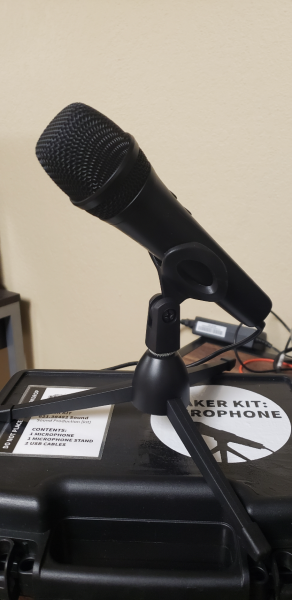
There is a concept in the world of libraries called the “Library of Things.” This growing movement recognizes that library can provide more than the traditional book and media resources, and some libraries now have collections of seeds, tools, board games, or cake pans. Within the Johnson County/Olathe Public Library system, one form this movement has taken is in the kits curated by the Makerspace team. These kits contain technology that you and I can check out, take home, and try something new. The newest offering in the kits line is the Sound Production Kit, and I checked one out to see how it works and what I could do with it.
Contents:
The kit comes as a durable plastic case with sliding latches. Inside, there is a microphone, desktop microphone stand, and 2 cables. In the kit I checked out, the cord held in the blue band was for hooking up to a Windows computer, and the red band held a cord for an Apple device. The bands are a nice touch for cable management, and each piece is neatly nested in impact resistant foam for storage and transport.

(The microphone included in the kit)
Use:
The microphone itself was simple to set up on the windows machine I used for testing. Once I plugged the USB cable into the mic and then into the PC, the light on top of the mic lit up and my computer installed the drivers. I tend to use the Digital Audio Workstation (DAW) Audacity as it is free to download and has a robust suite of features, but I also tried Microsoft Recorder, and Zoom, and the microphone was detected and worked for all three applications. The microphone has a headphone jack in its base, and two knobs on its top, one for gain and one for headphone volume. There is no studio jack or Bluetooth audio option within the mic, so you will need to either listen back with headphones on a standard 3.5mm jack or change your computer’s audio output to your preferred Bluetooth option each time you plug in the mic. Once you have your mic and headphones set up, record a couple test tracks to dial in your gain. Once you are happy with your levels, you are ready to record your first project!

(Example of Audacity DAW)
Impressions:
I tested the mic kit in the different ways I normally would think to use audio. For me, this took the form of podcasting, music recording, and teleconferencing. I quickly found that voice (spoken and sung) and ukulele both pick up well if you turn up the gain or move the mic closer to yourself. The low desktop mic stand holds the mic well, but has minimal adjustability, so I usually opted to change the gain since that was easier than moving the mic up to my face. With brass instruments, the gain had to be turned fairly low, but I was impressed at the playback I got with a plug and play condenser microphone. The audio playback was a little hard to control, as the headphone volume knob on the mic seemed touchy, but I was able to change the output as described above and my normal headphone setup worked fine.
The portability and ease of use are the main selling points of this kit to me. For recording a garage band live, interviews at an event, or recording while traveling, or one-off recording projects I could see this being a great tool. It is possible that someone could even use the library’s laptop kiosk to record in one of the study rooms, though you would probably need to save your individual tracks through Microsoft Recorder and assemble the final project later or use a web-based DAW as Audacity is not available on those devices. Dedicated recording equipment setups are not cheap, so the fact that the library now has three of these kits is a great addition to the collection.
